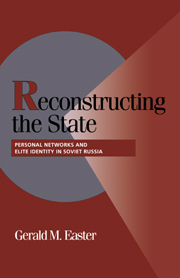Book contents
- Frontmatter
- Contents
- Preface
- 1 Introduction: Explaining State-Building Outcomes and the Soviet Russian Case
- Part I Structure and Identity in the Postrevolutionary State Elite
- Part II Informal Sources of Power in the Postrevolutionary State
- Part III Intrastate Conflict and the Constraints of Power Redefined
- 6 Center and Regions in Conflict I: Collectivization and the Crisis of Regional Leadership
- 7 Center and Regions in Conflict II: The Fall of the Provincial Komitetchiki
- 8 Conclusion: State Building and the Soviet Russian Case Reconsidered
- Notes
- Bibliography
- Index
- Titles in the series
7 - Center and Regions in Conflict II: The Fall of the Provincial Komitetchiki
Published online by Cambridge University Press: 13 October 2009
- Frontmatter
- Contents
- Preface
- 1 Introduction: Explaining State-Building Outcomes and the Soviet Russian Case
- Part I Structure and Identity in the Postrevolutionary State Elite
- Part II Informal Sources of Power in the Postrevolutionary State
- Part III Intrastate Conflict and the Constraints of Power Redefined
- 6 Center and Regions in Conflict I: Collectivization and the Crisis of Regional Leadership
- 7 Center and Regions in Conflict II: The Fall of the Provincial Komitetchiki
- 8 Conclusion: State Building and the Soviet Russian Case Reconsidered
- Notes
- Bibliography
- Index
- Titles in the series
Summary
The center–regional conflict of the 1930s was shaped by the constraints of power formed by the intersection of formal organizational and informal social structures within the postrevolutionary state. Despite the accumulation of formal powers in the state center, the Provincial Komitetchiki were nonetheless able to assert their own interests into the policy process during the early 1930s. Central leaders did not directly challenge the informal power resources of the Provincial Komitetchiki at this time. Instead, they resorted to a series of organizational reforms that ultimately failed to dislodge the Provincial Komitetchiki from the policy process. The years 1933 and 1934 were characterized by stalemate in the center–regional power struggle. During the mid-1930s, each side attempted to redefine the constraints of power to its own advantage. The Provincial Komitetchiki were unsuccessful in this attempt. Central leaders, however, devised a strategy that moved beyond the established parameters of constraint in the relationship. Through coercive resource mobilization and coalition building, the center engaged in a direct and systematic assault on the informal power resources of the regional leadership. As a result, central actors successfully restructured the relationship between center and regions in the new state. The power constraints in the center–regional relationship were not static, but dynamic. By the end of the 1930s, central actors, in general, and Stalin, in particular, were able to realize more fully their claim on the “despotic” powers of the state.
- Type
- Chapter
- Information
- Reconstructing the StatePersonal Networks and Elite Identity in Soviet Russia, pp. 133 - 160Publisher: Cambridge University PressPrint publication year: 2000



